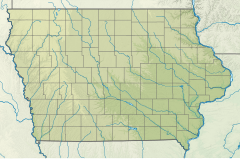Little Sioux River
Appearance
| Little Sioux River | |
|---|---|
 The Little Sioux River upstream of Spencer, Iowa | |
 The Little Sioux River, highlighted on a map of the watershed of the Missouri River | |
| Native name | Eaneah-waudepon (Lakota) |
| Location | |
| Country | United States |
| States | Minnesota, Iowa |
| Counties | Jackson County, Minnesota; Iowa: Harrison, Monona, Woodbury, Ida, Cherokee, Obrien, Clay, Buena Vista, Dickinson, Jackson |
| Physical characteristics | |
| Source | |
| • location | Okabena |
| • coordinates | 43°39′52″N 95°18′53″W / 43.6644052°N 95.3147212°W |
| Mouth | |
• location | Little Sioux |
• coordinates | 41°48′11″N 96°03′58″W / 41.803°N 96.066°W |
| Length | 258 mi-long (415 km) |
| Basin features | |
| River system | Missouri River |
The Little Sioux River is a
Sioux Indians. Its tributaries include the Ocheyedan River, Maple River and the West Fork of the Little Sioux River. The Little Sioux River is integral to the Nepper Watershed Project, a major Iowa flood control and soil conservation program that was introduced in 1947.[2]
At Turin, Iowa, the Little Sioux River has a mean annual discharge of 1,761 cubic feet per second.[3]
History
Ioways" labeled on this 1718 French map (the river today known as the Iowa River
is shown but not labeled).Prior to the
Ioways".[4]

The Little Sioux Valley was important in the
Santee Sioux chief Inkpaduta made forays as far downstream as Smithland. The river valley also figures prominently in folklore about the nineteenth century outlaw, Jesse James
, who reportedly used the secluded valley, with its wooded ravines, as a hideout and a route north to Minnesota during the 1870s.
Geology
Geologically, the Little Sioux rises in a region of
Spirit Lake, and East and West Okoboji). It then traverses a rich agricultural region on its way to the Loess Hills, from which it then flows out onto the floodplain of the Missouri River. Through much of its middle course (i.e., from Linn Grove to Smithland
) the Little Sioux is a relatively wild meandered stream, with excellent canoeing, camping, and fishing opportunities. However, from Smithland downstream to its mouth, the river has been channelized and environmentally degraded.
Flooding
Flooding of the river is common in early to late spring, as the often-heavy winter snow melts. This has resulted in
rabbits and pheasants
during the fall hunting season.
Fishing
Fishing opportunities are best in late spring after flood waters have dissipated. Edible
gamefish such as bullhead and channel catfish are frequently caught with nothing more than a hook and worm, with northern pike, walleye, and shovelnose sturgeon
also available.
See also
References
- ^ U.S. Geological Survey. National Hydrography Dataset high-resolution flowline data. The National Map Archived 2012-03-29 at the Wayback Machine, accessed March 30, 2011
- ^ U.S. Geological Survey Geographic Names Information System: Little Sioux River
- ^ "Little Sioux River". USGS.
- ^ "Paouté and Aiaouez : A New Perspective on Late Seventeenth-Century Chiwere-Siouan Identity".

